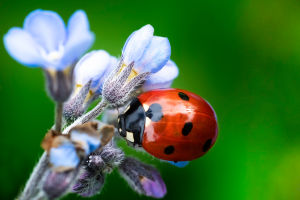
Hey Lykkers! We've all encountered ladybugs in our lives, whether as kids or adults. Their adorable red bodies with black spots are unforgettable, but did you know there's more to these insects than just their cuteness?
We've probably all heard that ladybugs with more spots (or "stars") are harmful, while those with fewer spots are beneficial. But is that really true? Let's dive into the fascinating world of ladybugs and discover the truth.
What Makes Ladybugs So Unique?
Ladybugs belong to the Coccinellidae family, and they come in many shapes, sizes, and colors. While the seven-spotted ladybug (Coccinella septempunctata) is probably the most famous, there are many other types, including some that are bright green or yellow instead of red.
Ladybugs' body shapes are usually round or oval, and their domed backs give them a distinct, recognizable look. Even though their color and spot patterns vary, they all belong to the same family and share some common features.
Do the Stars on a Ladybug Tell You Anything?
We've all been told that the number of spots or "stars" on a ladybug can determine if it's a pest or a beneficial insect. For example, ladybugs with seven spots are often said to be good for the garden, while those with more spots, like the 22-spotted ladybug (Psyllobora vigintiduopunctata), are believed to be pests.
However, this idea isn't entirely accurate. While it's true that some ladybugs are plant-eating pests, not all ladybugs with many spots fall into this category. For example, the multicolored ladybug (Harmonia axyridis) can have numerous spots, but it's actually a predator of aphids and other small pests, making it a valuable ally for gardeners.
Ladybugs: A Mixed Diet
Ladybugs are not all the same when it comes to their diets. They can generally be categorized into three groups: those that eat fungi, those that are predators (like aphid-eating ladybugs), and those that feed on plant leaves.
Interestingly, even some of the ladybugs with fewer spots are also predators, while others with more spots feed on plants. This means that the number of spots is not a reliable way to classify them as pests or beneficial insects. Some ladybugs, like the seven-spotted ladybug and the multicolored ladybug, are voracious predators of aphids, while others may prefer munching on plant leaves.
Ladybugs and Biological Pest Control
Ladybugs play a crucial role in biological pest control. These little predators are used in agriculture and gardening to keep aphid populations in check. Ladybugs lay their eggs on plants infested with pests, and when the larvae hatch, they immediately start hunting for food.
This natural method of pest control helps reduce the need for chemical pesticides, making our gardens more eco-friendly. We can often find ladybug egg cards being distributed in parks, where they hatch into larvae that help reduce aphid numbers.
The Life Cycle of a Ladybug
Ladybugs undergo a complete metamorphosis, meaning they go through four stages in their life: egg, larva, pupa, and adult. The larvae are often quite active and look very different from adult ladybugs. They have long, spiky bodies and are excellent hunters. They crawl around searching for aphids and other small insects to eat. Once the larvae mature, they enter the pupal stage, where they transform into adult ladybugs.
Are Ladybugs Harmful or Helpful?
It turns out that ladybugs can be both harmful and helpful, depending on their species. While some ladybugs are indeed pests that damage crops by feeding on plant leaves, many of them are beneficial because they help control aphids and other pests. The best way to tell if a ladybug is helpful or harmful is not by counting the number of spots but by understanding what it eats and how it behaves.
Ladybugs in the Winter
In winter, ladybugs often gather in groups to hibernate. They seek out sheltered, warm places to wait out the cold months. This is why we might find groups of ladybugs inside our homes during the colder seasons. The ladybugs don't do any harm—they're just trying to survive until the weather warms up again. Some ladybugs, like the seven-spotted ladybug, can live for up to a year, and their ability to hibernate helps them thrive through tough winters.
Final Thoughts: The True Role of Ladybugs
So, what have we learned, Lykkers? Ladybugs are fascinating creatures with a wide variety of behaviors and diets. The number of spots doesn't determine if they're pests or beneficial insects, as many spotted ladybugs are actually great at keeping pests under control.
Understanding their role in the ecosystem can help us appreciate these little beetles and even use them to help protect our gardens in a natural, eco-friendly way. Let us know what you think about ladybugs in the comments below!


